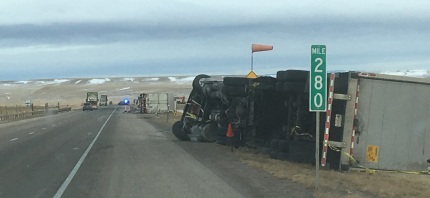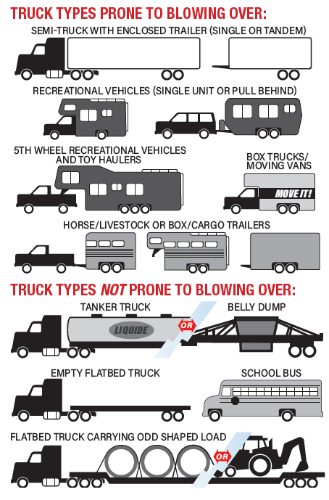- Home
- Administration
- Aeronautics
- Business with WYDOT
- Construction Projects
- Driver License and Records
- Economic Stimulus Projects (ARRA - TIGER)
- Engineering and Technical Programs
- Fuel Tax
- Highway Safety
- Human Resources
- Manuals and Publications
- News and Information
- Permits
- Planning/Projects/Research
- Titles, Plates and Registration
- Travel
- Trucking / Commercial Vehicles
- Vehicle Business Regulation
- Wyoming Highway Patrol
- Search
- Sitemap
Wyoming Wind
Strong winds may prompt Weight-based Wind Closures (WBWC)

WYDOT has been closing sections of highway to “light, high-profile vehicles” since 2011 due to strong crosswinds and extreme blow over risk.
However, given the large amount of out-of-state commercial vehicle traffic and the hurricane-force winds often seen in Wyoming, WYDOT has received feedback over the years to define light, high-profile vehicles.
Recent research from the University of Wyoming, funded by WYDOT’s Research Advisory Committee, helped the agency more confidently list actual weights with the restrictions. The weight-based wind closure system started in 2023.
Wyoming's winds can pose an extreme blow over risk
WYDOT Report - Weight Based Wind Closures
Frequently Asked Questions
WYDOT has received questions about the new Weight-based Wind Closure (WBWC) system. We've compiled them into the below resource. Do you have additional questions? Email us!
Important note: if strong winds are making it hard to keep control of your vehicle, regardless of its weight or shape, we recommend pulling over in a safe location (rest area, parking area, or town) to wait for winds to subside.
Q: When the sign includes a weight, what is included in that number?
A: The weight listed is based on Gross Vehicle Weight (GVW). GVW is the total weight of the truck and payload at a point in time, including any persons in the vehicle and all contents of the tractor and trailer.
Wyoming statute 31-1-101 (a)(vii) says: "Gross vehicle weight" means the total weight of a vehicle or vehicle combination including the unladen weight of the vehicle or vehicle combination plus the maximum legal declared weight of the load to be carried in or on the vehicle or vehicle combination”
Q: What does “enclosed trailer” mean?
A: Box shaped or van-type trailers, with large vertical surface area, are more susceptible to blowing over. Examples can include, but are not limited to: refrigerated freight (sometimes called reefers), dry freight, horse trailers, fifth-wheel campers, small cargo trailers, cattle haulers, recreational vehicles or other enclosed trailers.
Q: What types of vehicles are included? Which are not?
A: The closures still apply to “light, high-profile vehicles.” However, WYDOT is working to better define this term.
WYDOT’s experience shows that enclosed trailers (e.g. 53-foot box trailers and doubles) are most susceptible to being blown over. Tankers and flatbed trailers that are unloaded or are not hauling a high-profile load, such as cargo containers, are also less risky and typically not included in the weight-based wind restrictions.
Although they do not have a trailer, box trucks (like rental moving trucks) are included in this restriction.
If a driver is pulling a double, we are still talking about the total weight of the tractor and trailers. While we cannot specify how the trailers are loaded, it would be very dangerous to load one trailer completely while the second trailer is empty.
Other eligible vehicles include recreational vehicles, camper trailers, cattle haulers, and other enclosed trailers. Other vehicles that do not seem to be susceptible to blowing over are school buses.
Q: My GVW is only 5,000-10,000 more than the weight listed on the signage. Is it safe for me to go?
A: WYDOT tries to keep the signage as up-to-date as possible based on current and forecasted wind conditions. Even so, winds can be unpredictable and there could still be blow over risk for vehicles close to the listed weight. While drivers above the listed weight are permitted to proceed, WYDOT recommends drivers use their best judgment, as sensors may not be positioned in the areas with the strongest winds. Drivers assume their own risk. To reiterate: if strong winds are making it hard to keep control of your vehicle, regardless of its weight or shape, we recommend pulling over in a safe location (rest area, parking area, or town) to wait for winds to subside.
Q: How were you able to make these changes without legislative action?
A: Wyoming statute 24-1-106 gives WYDOT the ability to “restrict the use of, or close, any state highway whenever the department considers the closing or restriction of use necessary” including to protect the public.
Wyoming Statute 24-1-109 provides WYDOT with the ability to “....allow a person to proceed past any sign, marker, warning, notice or other device posted pursuant to W.S. 24-1-108…”
This messaging change does not affect fine amounts or contradict any legislation; adding the weights to the signage is purely meant to better inform drivers at risk of blowing over.
Q: Why did you make these changes?
A: The Legislature instructed WYDOT to work to reduce blow over crashes.
WYDOT has been closing sections of highway to “light, high-profile vehicles” since 2011. However, given the large amount of out-of-state commercial vehicle traffic and the hurricane-force winds often seen in Wyoming, WYDOT has received feedback over the years to define light, high-profile vehicles. This effort is in response to those comments. Recent research from the University of Wyoming, funded by WYDOT’s Research Advisory Committee, helped the agency more confidently list actual weights with the restrictions.






